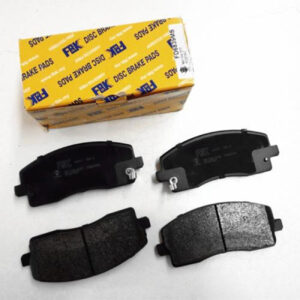Description
TRW has achieved another braking first.
TRW has introduced Cotec – an innovative coating for its brake pads. Independent tests have proven that Cotec achieves significantly shorter stopping distances than the brake pads
of major competitors or even OE, for the first stops after leaving a garage following a brake pad change.
In the normal bedding in process there is a period, known as the ‘green behaviour’ of the pad, which occurs at the start of the bedding in process where the friction co-efficient is lower than usual.
Drivers can find it difficult to adjust to the difference in performance during these first stops. TRW Cotec brake pads address this issue by improving the contact between the brake disc and pad.
Independent testing
In independent tests, TRW Cotec out performed major competitors and OE during the first stops by at least a car length.
The Range
TRW has made the decision to coat all of its brake pads with Cotec. The changeover is already underway with 450 of the fastest moving references, covering 90% of the European car parc, already
Cotec coated.
Scorching
Scorching is a vital part of the manufacturing process and involves heating the brake pad material to 600-700°C. Scorching allows the evacuation of gases and resins, trapped inside the
friction material at the mixing stage. This helps to reduce the bedding in time to a minimum.
Advanced plate scorching – the OE standard
Not all aftermarket suppliers carry out scorching to the same level as TRW. Indeed, some don’t carry out the process at all.
TRW utilises advanced heat plate scorching. Not only is this the OE standard, but it is more effective and uses less energy than conventional scorching techniques.
During the process of advanced heat plate scorching, the friction material of the brake pad is pressed to a heated plate. This heats the matrix of the friction material, allowing carbonization
to occur to the first 0.5 to 1.5mm of its surface.
Friction material
The friction material is the most important part of a brake pad. All TRW’s brake pads contain the optimum mix of raw materials from rubber to graphite.
TRW has made a significant investment over the years to ensure that we have the perfect mix – and we make it in-house.
The ingredients ensure a stable friction coefficient and the safest braking performance in all temperatures, at all speeds and under all conditions.
Back plate function
Brake pad back plates are high-quality steel plates that carry the friction material required for the braking function. The friction material is bound to the disc-facing surface of the back plate.
The backing plate is powder coated which protects the back plate from rust.
Unique TRW design
The backing plates used by TRW are designed, patented and produced in-house to OE specification. They are fitted to the friction material with a unique adhesive compound which can
withstand high temperatures and resists extremely high shear strengths.
Tested to the extreme
All TRW brake pads undergo a rigorous set of tests during production and on the road and the aftermarket testing mirrors OE procedures. Many aftermarket suppliers in Europe consider
their adherence to ECE R90 specifications as a mark of excellence, but for TRW, this is a minimum.
TRW goes the extra mile with its testing procedures and its brake pads undergo a further shear strength test during production control – this ensures the pad material will not separate from the backing plate.
Quietly confident
TRW places great emphasis on noise reduction and its brake pads are fitted with high quality shims which act as a damper between the friction material and the brake caliper.
Our friction components are not only tested in our NVH (noise vibration harshness) laboratories and also on the road.
OE quality
But TRW is taking things to the next level. For the best possible performance, TRW now uses a fibre glass material instead of rubber for its shims. And where at an OE level, vehicle manufacturers
use a metal shim held in place with special adhesive – TRW’s aftermarket parts follow suit.
And for the best possible noise reduction, many TRW pads have integrally moulded shims and a multi-layer construction.




